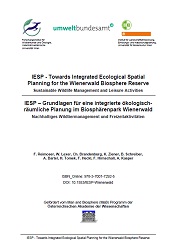In order to support integrative sustainable land use, the technical and methodological
groundwork for preventive management of conflicts between the habitat requirements of wild
animals and human land use demands has been developed based on the example of recreation
activities in the Biosphere Reserve Wienerwald. Assessment results have been mapped
in a spatially explicit way for the Wienerwald region, whereas the methods of modeling, mapping
and analyzing conflict potentials, the portfolio of management options, and the concept
for linking management interventions with spatial conflict potential analysis are in principle
transferable to other regions. Project results are targeted at all actors in the Biosphere Reserve,
but also in other regions, that are involved in the emergence of conflict potentials, affected
by the consequences of conflicts, able to influence conflict management processes, or
are otherwise interested in conflict resolution. Main results include:
* Profiles characterizing indicator wildlife species and indictor recreational activities;
* Sets of maps and descriptive assessments of the habitat situation, distribution and spatial
habitat use of indicator species as well as of the spatial distribution of use intensities
of indicator recreational activities;
* Assessment results and sets of maps of spatial conflict potentials between wild animals
and recreational activities on the scale levels of in-depth investigation areas and the entire
Biosphere Reserve;
* Transferable tool box of methods for GIS-based modeling of recreational use potentials
and for spatial analysis of conflict potentials;
* Catalog of strategies and management options for conflict management (visitor management;
information, communication and public relations; land use sectors; monitoring
and adaptive management);
* Concepts, recommendations and decision support for prioritizing, selecting and arranging
management objectives and management actions in a spatially differentiated way
and according to varied conflict values;
* Strategic recommendations for further use and capitalization of project results and for a
participatory follow-up process aimed at implementing integrated spatial and ecological
conflict management approaches in the Wienerwald Biosphere Reserve.
Zur Verbesserung einer integrativen nachhaltigen Landnutzung wurden fachliche und methodische
Grundlagen für ein vorausschauendes Management von Konflikten zwischen den
Lebensraumansprüchen von Wildtieren und Landnutzungsansprüchen des Menschen am
Beispiel von Freizeitnutzungen im Biosphärenpark Wienerwald entwickelt. Die Ergebnisse
sind über räumlich explizite Karten auf die Region Wienerwald bezogen; die Methoden der
Konfliktpotenzialmodellierung und –analyse, Maßnahmenempfehlungen und das Konzept zur
Verknüpfung von Maßnahmen und räumlicher Konfliktpotenzialanalyse sind grundsätzlich
auf andere Gebiete übertragbar. Die Ergebnisse des Projekts richten sich an alle Akteure im
Biosphärenpark sowie darüber hinaus auch in anderen Regionen, die an der Entstehung von
Konfliktpotenzialen beteiligt sind, von Konfliktfolgen betroffen sind, Einflussmöglichkeit auf
Konfliktmanagementprozesse besitzen oder an Konfliktlösungen interessiert sind. Die Ergebnisse
umfassen:
* Profile und Charakterisierung von Indikator-Wildtierarten und Indikator-
Freizeitaktivitäten;
* Kartensätze und Beschreibungen der Lebensraumsituation, Verteilung und Raumnutzung
der Indikatorarten sowie der räumlichen Verteilung von Nutzungsintensitäten
bzw. -wahrscheinlichkeiten der Indikator-Freizeitaktivitäten;
* Analyseergebnisse und Kartensätze der räumlichen Konfliktpotenziale zwischen Wildtieren
und Freizeitnutzungen auf den Ebenen der Intensivuntersuchungsgebiete und des
gesamten Biosphärenparks;
* Übertragbarer Methodenbaukasten zur GIS-basierten Modellierung von Nutzungspotenzialen
für Freizeit- und Erholungsnutzungen und zur räumlichen Analyse von Konfliktpotenzialen;
* Katalog von Handlungsstrategien und Maßnahmenoptionen für das Konfliktmanagement
(Besuchermanagement; Information, Kommunikation und Öffentlichkeitsarbeit; sektorale
Landnutzergruppen; Monitoring und adaptives Management);
* Konzepte, Empfehlungen und Entscheidungshilfen zur räumlich differenzierten
Priorisierung, Auswahl und Ausgestaltung von Managementzielen und –maßnahmen in
Abhängigkeit von unterschiedlichen Konfliktausprägungen;
* Strategische Empfehlungen zur weiteren Verwendung von Projektergebnissen und für
einen partizipativen Folgeprozess zur Umsetzung eines räumlich-ökologischen Konfliktmanagements
im Biosphärenpark Wienerwald.



